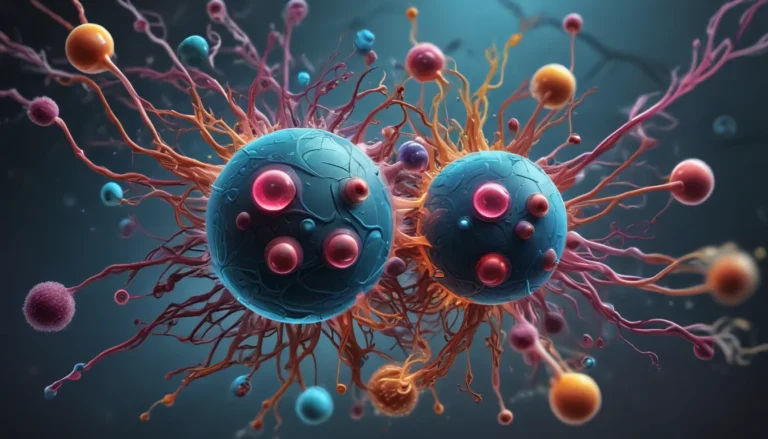A Note About Images: The images used in our articles are for illustration purposes only and may not exactly match the content. They are meant to engage readers, but the text should be relied upon for accurate information.
Stem cell research has emerged as a captivating and ever-evolving field that has piqued the interest of scientists and researchers worldwide. With their remarkable ability to transform into various cell types within the body, stem cells hold immense promise for significant advancements in medical treatments and therapies.
In this exploration of the enigmatic realm of stem cell research, we uncover 15 intriguing facts that will broaden your understanding of this revolutionary field. From the origins of stem cells to their applications in regenerative medicine, the world of stem cell research continues to reshape the landscape of healthcare, offering hope for improved treatments and therapies.
So, let’s embark on this enlightening journey as we delve into the fascinating world of stem cells and the extraordinary strides being made in the realm of stem cell research.
Embracing the Potential of Stem Cells:
- Stem cells possess the extraordinary potential to revolutionize the treatment of a vast array of diseases, ranging from cancer to spinal cord injuries, by differentiating into specialized cell types. This opens up exciting avenues for revolutionary regenerative medicine therapies.
- Stem cell research is a dynamic and ever-evolving field, characterized by ongoing discoveries and innovations. It holds the promise of organ creation, insights into the aging process, and contributions to economic growth through pioneering therapies.
Exploring the Virtues of Stem Cells:
Stem cell research offers a beacon of hope for addressing various conditions such as cancer, Alzheimer’s disease, spinal cord injuries, and diabetes. The unique ability of stem cells to differentiate into specialized cell types underscores their significance in regenerative medicine.
Unveiling the Diverse Sources of Stem Cells:
Stem cells can be sourced from a multitude of origins, including embryos, adult tissues, and even amniotic fluid. Of particular note are embryonic stem cells, which exhibit pluripotency and the capacity to develop into any cell type within the body.
Navigating the Controversies Surrounding Stem Cell Research:
The utilization of embryonic stem cells has sparked ethical debates due to concerns over embryo destruction. This ethical quandary has ignited global discussions and prompted the establishment of stringent guidelines and regulations to govern stem cell research practices.
Pioneering Advances in Stem Cell Technology:
The advent of induced pluripotent stem cells (iPSCs) represents a groundbreaking milestone in stem cell research. Reprogramming adult cells into iPSCs, akin to embryonic stem cells, has ushered in a new era of potential for studying diseases and crafting personalized treatments.
Illuminating the Path of Stem Cell Research:
A cornerstone of stem cell research lies in its regulation to uphold ethical standards and responsible practices. Countries worldwide have enacted guidelines to ensure the conscientious and ethical conduct of stem cell research endeavors.
Unleashing the Potential of Stem Cells in Drug Testing:
By cultivating specialized cells from stem cells, researchers can assess the impact of new drugs in a controlled setting. This holds the promise of reducing reliance on animal testing and streamlining the drug development process.
Deciphering the Mysteries of Aging Through Stem Cells:
The study of stem cell behavior offers a gateway to unraveling the mechanisms underpinning the aging process. Scientists aspire to glean insights into aging mechanisms and potentially devise interventions to decelerate or reverse the aging trajectory.
Embracing the Experimental Horizon of Stem Cell Therapies:
While the potential of stem cell therapies is vast, many treatments are in the experimental phase and await widespread clinical approval. These ongoing endeavors underscore the transformative potential of stem cell therapies in healthcare.
Charting the Course to Organ Generation:
Researchers are exploring the feasibility of utilizing stem cells to engender functional organs for transplantation, addressing the scarcity of donor organs. This innovative approach holds promise for revolutionizing transplant medicine.
Safeguarding the Biological Assets:
Stem cell banks afford individuals the opportunity to store their own stem cells for potential future utilization in regenerative therapies, fostering a personalized approach to healthcare.
Uniting Forces with Veterinary Medicine:
The domain of veterinary medicine has harnessed the potential of stem cell therapies, offering treatments for ailments such as arthritis in dogs and horses. This interdisciplinary collaboration underscores the versatility and applicability of stem cell research.
Fostering Healing Through Tissue Regeneration:
Injections of stem cells into injured tissues can catalyze healing and regeneration, presenting a beacon of hope for individuals grappling with conditions like heart disease or spinal cord injuries.
Catalyzing Innovations in Tissue Engineering:
By amalgamating stem cells with biomaterials, scientists are forging artificial tissues and organs in laboratory settings, paving the way for transformative medical advancements.
Spearheading Economic Growth Through Stem Cell Research:
The realm of stem cell research harbors economic implications by virtue of its potential to foster economic growth through innovative therapies and job creation in the burgeoning biotechnology sector.
Nurturing the Evolution of Stem Cell Research:
The landscape of stem cell research is characterized by continual evolution, with novel discoveries and breakthroughs propelling the field forward and expanding our comprehension of their manifold applications.
In Conclusion:
In essence, stem cell research harbors the boundless potential to redefine the domain of medicine and offer solutions for an array of diseases and conditions. These enigmatic cells, endowed with the remarkable ability to differentiate into any cell type in the body, stand as a pivotal resource for regenerative medicine and tissue engineering.
The elucidation of the 15 pivotal facts about stem cell research encapsulated in this discourse sheds light on the captivating realm of stem cells, from their inception to their therapeutic applications. From unraveling their role in embryonic development to harnessing their regenerative potential, researchers persist in exploring novel avenues to unlock the full spectrum of these cells’ potential.
Despite the controversies that veil stem cell research, the imperative lies in prioritizing ethical practices and regulations to ensure their conscientious and beneficial application. With relentless advancements and scientific breakthroughs, stem cell research holds the promise of instilling renewed hope in patients and reshaping the future landscape of medicine.
FAQs:
-
What are stem cells?
Stem cells are undifferentiated cells with the ability to develop into diverse specialized cells in the body. -
Where do stem cells originate from?
Stem cells can be derived from various sources, including embryos, adult tissues, and umbilical cord blood. -
Why is stem cell research significant?
Stem cell research holds the potential to unveil treatments and cures for a wide spectrum of diseases and injuries. -
Are there different types of stem cells?
Indeed, different types of stem cells exist, including embryonic stem cells, adult stem cells, and induced pluripotent stem cells. -
How are stem cells employed in medicine?
Stem cells can be utilized in medicine for regenerative purposes, such as replenishing damaged cells, tissues, or organs. -
Do ethical concerns encircle stem cell research?
Yes, ethical dilemmas emerge due to the use of embryonic stem cells, entailing embryo destruction. Nevertheless, alternative sources like adult stem cells mitigate these concerns. -
What potential realms can stem cell research explore?
Stem cell research holds potential in addressing conditions such as Parkinson’s disease, Alzheimer’s disease, diabetes, spinal cord injuries, and heart disease, among others. -
Is stem cell research subject to regulation?
Certainly, stringent regulations and guidelines govern stem cell research to ensure ethical practices and mindful stem cell use. -
How long has stem cell research been prevalent?
Stem cell research has been a continued endeavor for several decades, witnessing significant strides in recent years. -
Can stem cells be personalized for medical use?
Absolutely, stem cells harbor the potential to be tailored for personalized medicine, as they can be sourced from a patient’s own cells for customized treatments. -
What challenges accompany stem cell research?
Challenges include the ethical discourse, safety apprehensions, and the requisite for enhanced research to fathom the complete potential of stem cells. -
Are there limitations to stem cell research?
Limitations engross the challenges in regulating stem cell differentiation and the risk of tumor development without stringent oversight. -
Can stem cells be leveraged to combat genetic disorders?
Indeed, stem cells pose promise in treating genetic disorders through gene replacement or cell restoration. -
How are stem cells integrated into research efforts?
Stem cells are employed in research to scrutinize diseases, evaluate potential treatments, and cultivate a comprehensive understanding of cellular mechanisms. -
Can stem cells tread the realm of cosmetic purposes?
Although stem cells are being considered for cosmetic utilities, extensive research is warranted to ascertain their safety and efficacy.
Stem cell research endures as a captivating pursuit for both scientists and the populace, promising groundbreaking medical discoveries. Should you yearn for further enthralling insights into this revolutionary expanse, consider delving into the nuances of embryonic stem cell research, which presents a distinctive array of opportunities and challenges. Delve into our repository of extraordinary facts surrounding stem cells to grasp their versatility and application potential across diverse domains. Lastly, acquaint yourself with the legacy of Dr. Shinya Yamanaka, a trailblazing figure whose monumental contributions have steered the course of stem cell research to its current zenith.
Nurturing Your Call to Action:
Our commitment to furnishing authentic, engaging content stands as the crux of our ethos. Each fact unveiled on our platform emerges from authentic user contributions, imbuing our repository with a cornucopia of diverse insights and knowledge. Our steadfast dedication to upholding the highest standards of precision and authenticity is epitomized in our meticulous review process, ensuring that every fact disseminated is not only captivating but also veritable. Rest assured in our unwavering vow to quality and authenticity as you traverse and delve into the realms of learning and discovery with us.






